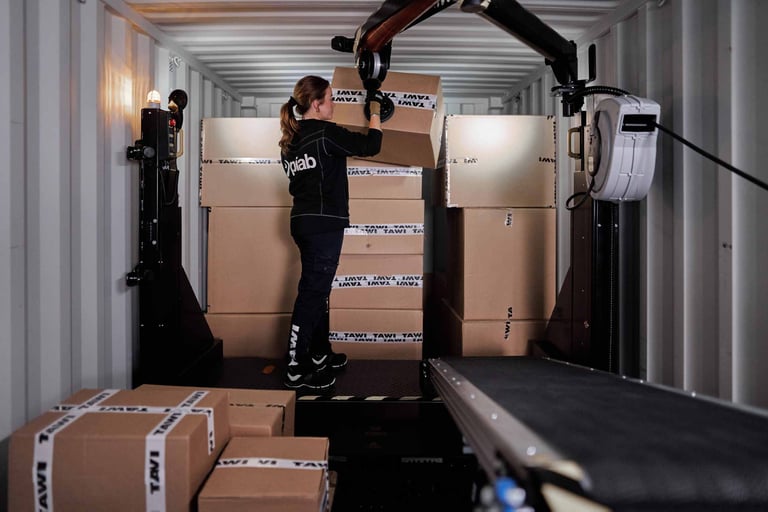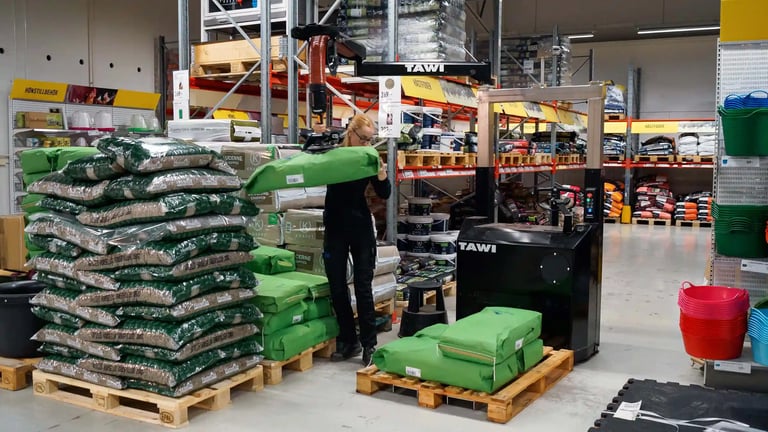Efficient loading and unloading in a warehouse

Well-organized loading and unloading are key to an efficient logistic process. Taking a step towards automation in your manual handling processes is an essential strategy to make your logistic workforce more efficient.
Ergonomic lifting equipment offers you a step from a fully manual handling position onto the journey of automation – a quick, cost-efficient and sustainable step.
Changing Consumer Demands – A Challenge or an Opportunity?
Increasing online shopping is fundamentally changing the requirements of logistic centers. As consumers do more of their shopping online, the demand for package delivery continues to grow. Simultaneously, the supply chain is more and more moving toward just-in-time delivery, leaving logistic companies with even less room for error. Optimizing loading and unloading is vital to overall supply chain efficiency.
Loading and unloading of trucks or shipping containers need to be speedy and efficient, managing cartons of varying sizes and weights. The same thing is true for warehouse order picking and palletizing. Today’s consumers expect quick delivery, putting high demands on efficient order picking, loading and unloading.
Safety Starts and Ends with Your Workforce
An important factor to consider when loading and unloading of goods is the safety of your personnel. Safety should always be a key consideration when manually handling cargo since it can be a dangerous operation that can cause injury to warehouse workers. In 2018, the U.S. Bureau of Labor Statistics received 221,400 reports of workplace-related injuries and illnesses in the transportation and warehousing industry. Safety starts and ends with your workforce, and human error is a primary cause of injury in the goods-receiving area. To prevent injury and chronic illness due to manual handling, training in ergonomic movements is a must.
It is also important to make sure that any equipment that is being used in loading and unloading operations is in good working condition and that all safety protocols are being followed. Additionally, make sure that any personnel that are involved in these processes are properly trained to know how to do so safely. Many companies have implemented safety training programs for their workers. This type of training will help ensure that everyone understands the importance of proper manual handling operations and that they can correctly follow the safety protocols. Additionally, regularly inspecting your loading and unloading areas for any potential safety hazards can help to keep your personnel safe while they are working.
Well-organized loading and unloading of containers or trucks is key to an efficient logistic process. Manually loading or unloading containers is time-consuming and strenuous work with a high risk of injury. These processes often involve lifting parcels from above shoulder height and twisting when lifting, which is hazardous work. Climbing to reach cargo in trucks and shipping containers is a leading cause of slips, trips and falls. The good news is that when equipped with proper lifting aids, workers can save their strength, avoid injury, and speed up work, effectively saving both time and money.
The Importance of Loading and Unloading in a Warehouse and How to Improve the Processes
Loading and unloading in a warehouse is a critical part of the supply chain. It is important for warehouse operators to have a well-thought-out plan for how to safely, quickly, and efficiently move goods from one location to another. It is also important to have the right equipment and personnel in place to ensure the process is done correctly. There are several ways to optimize warehouse loading and unloading procedures.
5 Steps for Boosting Loading and Unloading Efficiency:
- Ensure that your employees receive the training they need to load and unload efficiently
- Be aware of common mistakes that can cause inefficiencies, such as wasted space in the trailer/container and nonergonomic movements. Workers must lift with their legs and keep the package close to their body. They shouldn’t lift anything heavier than 44-55 lbs by themselves or without the right lifting equipment.
- The layout of the warehouse should be optimized to make sure that items are located close to where they need to be loaded and unloaded. By optimizing the warehouse layout, loading and unloading times can be reduced.
- Lean management principles can help improve loading and unloading efficiency. This involves optimizing processes by eliminating unnecessary steps. It also involves streamlining processes and creating efficient communication between staff members.
- Take a step from manual handling to automation. Ergonomic lifting equipment is a cost-efficient and easily integrated step that can have a considerable effect on your loading and unloading efficiency.
TAWI Loading and Unloading Solutions
TAWI has developed a mobile Container Unloader and a Mobile Order Picker to optimize warehouse loading, unloading and picking. These user-friendly and smart lifting solutions ensures ergonomic and efficient operations.
Flexible and High-Speed Order Picking
TAWI Mobile Order Picker is a quick and user-friendly vacuum lifter that can handle cartons of varying sizes, paper or plastic bags, drums, sheets, or anything else that can be lifted with vacuum. The vacuum lifter is easily attached to any forklift or pallet jack used when picking goods, ensuring a speedy and flexible process. A clever solution that will facilitate order picking in any warehouse or logistic unit.

Safe & Time-Efficient Container Unloading
With the TAWI Container Unloader, any operator, no matter their size or strenght, has the ability to reach all goods inside of a shipping container, from the top to the bottom. You can save you business time and money with an efficient lifting system for unloading, while also providing a safe and ergonomic work space for your employees.